Occlusion
In dentistry we use the word occlusion to describe how the teeth fit together when a person bites down. When teeth do not fit together properly it is noted as a malocclusion. A malocclusion has several criteria:
- How the molar teeth fit together
- How the canine (cuspid) teeth fit together
- The position of teeth relative to each other
Class I Malocclusion
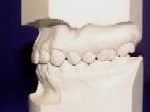
This classification is used when the bite is relatively correct, the upper first molar cusp lines up with the developmental groove of the lower first molar and the teeth have proper relation of the cusps and fossa. The cusp tip of the upper cuspid fits between the lower cuspid and the lower first bicuspid. The teeth, however, are crowded, crooked, or rotated.
Class II Malocclusion
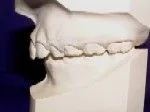
This classification is used when the upper front teeth protrude out past the lower front teeth. The dental term of this protrusion is “overjet”. The upper first molar cusp lines up forward of the developmental groove of the lower first molar. The cusp tip of the upper cuspid is forward of the lower cuspid. The teeth may be crowded, crooked, or rotated.
Class III Malocclusion

This classification is used when the lower first molar is anteriorly placed in relation to the upper first molar. The lower anterior teeth are edge to edge or forward of the upper anterior teeth. This is also called an underbite. The teeth may be crowded, crooked, or rotated.
Open Bite
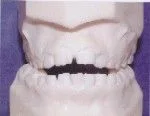
A condition in which the upper and lower front teeth fail to contact when biting down. The patient cannot bite into foods with their front teeth and sometimes a child may lisp when speaking. An open bite is usually caused by thumb, finger, and pacifier habits or tongue thrusting.
Overbite – Deep Bite

In an over bite the upper front teeth extend too far over the lower front teeth, upon closure the lower teeth bite too close or into the gum tissue on the palate behind the upper front teeth. This type of bite can lead to excessive wear on the anterior teeth, protruding lips and smile which exhibits more gum tissue.
Overjet- Protruding Upper Front Teeth
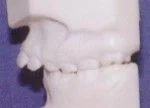
The dental term “overjet” defines what some people sometimes referred to as “bucked teeth”. Excess overjet is noted when the upper front teeth protrude forward of the lower front teeth. When upper front teeth are positioned forward they become more susceptible to chipping, fracture or even being knocked out. It is important to determine the underlying cause of protruding teeth. If it is due to a habit of thumb, finger, or pacifier sucking, a thumb appliance may be recommended. If it is due to uneven jaw growth, orthodontic appliances can be used to correct the problem.
Underbite – Anterior Crossbite
When the lower jaw is longer than the upper jaw the lower front teeth protrude. When the patient closes their teeth together the upper front teeth are behind the lower front teeth. This problem occurs in a very low percentage of children but is serous and early treatment can reduce the need for aggressive surgery as an adolescent or adult. (Refer to Class III above)
Crossbite - Posterior
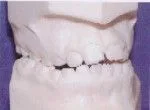
Upon biting, the posterior upper teeth bite inside the lower teeth. This condition can be the result of a thumb, finger, or pacifier habit; however, in some circumstances it is due to an airway problem. If your child is a mouth breather (always breathing with the mouth opened) or snores the problem may be due to enlarged adenoids and tonsils. Dr. West may refer you to your Pediatrician or an Ear, Nose, and Throat specialist.
Crowded Teeth
This condition is noted when there is not enough space for all the permanent teeth to erupt,the teeth are larger than the dental arch. Sometimes it is noted early when the permanent front teeth begin to erupt. Even when the front teeth appear aligned the crowding may present itself as the upper cuspid erupts at about eleven to thirteen (11-13) years of age. Ideally, this condition can be recognized and corrected early. If left uncorrected the bone over the roots of crowded teeth can become thin and allow the gum tissue to recede exposing the root of the tooth, this condition disfigures a smile.
Midline Discrepancy
A midline discrepancy is recognized when the midline between the upper central incisors does not match the midline of the lower central incisors on full closure of the bite. Another form of discrepancy is noted if either midline does not line up with an imaginary line drawn down the center of the nose.
Spacing
Some patients appear to have more space than is needed for the proper fit of their teeth. This situation may occur because they are congenitally missing permanent teeth are they have a tooth size discrepancy. This can present an esthetic concern for patients. For orthodontic purposes the most frequently missing teeth are bicuspids. When there is a tooth size discrepancy it usually involves the upper lateral incisors.
Impacted Teeth
When teeth are positioned such that they are unable to erupt properly they are termed impacted. Many people have been advised that their third molars (Wisdom Teeth) are impacted due to the lack of space in the dental arch for these teeth to erupt and assume a proper bite relationship
Infrequently, a maxillary cuspid will demonstrate a similar condition requiring the impacted tooth to be surgically uncovered and drawn into the dental arch during orthodontic treatment.
Correction of Spacing Due of Traumatic Loss of an Anterior Tooth
When a patient is missing a front tooth because of facial trauma in which a tooth has been knocked out of the mouth it is very easy to camouflage the space so that it appears a tooth is present. If you can retrieve the tooth that has been knocked out and it is deemed inappropriate to re-implant it, the space can still be maintained esthetically during orthodontic treatment. Orthodontic brackets can be placed on the appropriate teeth; the displaced tooth is re-contoured to fit up next to the gum tissue. An orthodontic bracket is placed on the modified tooth and the tooth is attached to an arch wire and upon completion of treatment a more permanent replacement can be fabricated.



